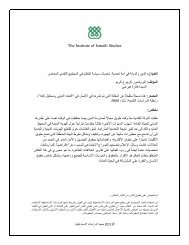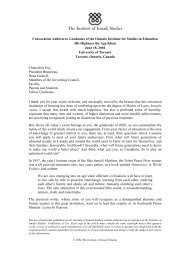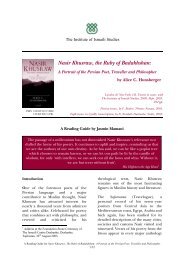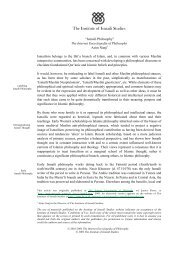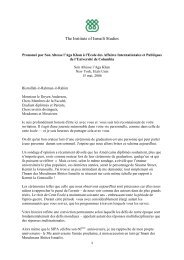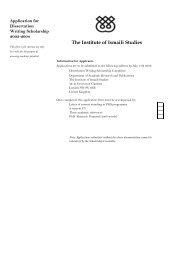The Institute of Ismaili Studies 1
The Institute of Ismaili Studies 1
The Institute of Ismaili Studies 1
Create successful ePaper yourself
Turn your PDF publications into a flip-book with our unique Google optimized e-Paper software.
Anjudan to the nearby village <strong>of</strong> Kahak, near Qum and Mahallat, ending the Anjudan period in post-<br />
Alamut Nizari <strong>Ismaili</strong>sm.<br />
By the middle <strong>of</strong> the 12 th AH/18 th CE century, in the unsettled conditions <strong>of</strong> Persia after the demise <strong>of</strong><br />
the Safavids and the Afghan invasion, the Nizari imams moved to Shahr-e Babak in Kirman, a<br />
location closer to the pilgrimage route <strong>of</strong> the Khojas who regularly traveled from India to see their<br />
imam and deliver their religious dues. Soon, the imams acquired political prominence in the affairs <strong>of</strong><br />
Kirman. <strong>The</strong> forty-fourth imam, Imam Abu’l-Hasan, also known as Imam Sayyid Abu’l-Hasan<br />
Kahaki, was appointed around 1170 AH/1756 CE to the governorship <strong>of</strong> the Kirman province by<br />
Karim Khan Zand; earlier he had been the beglerbegi or governor <strong>of</strong> the city <strong>of</strong> Kirman (Vaziri, pp.<br />
543-65). It was in his time that the Ne‘mat-Allahi Sufi order was revived in Persia. Imam Abu’l-<br />
Hasan had close relations with Nur-‘Ali-Shah and Mushtaq-‘Ali-Shah among other Ne‘mat-Allahi<br />
Sufis in Kirman (Daftary, 1990, pp. 498-503). After Imam Abu’l-Hasan’s death in 1206 AH/1792 CE,<br />
his son Imam Shah Khalil-Allah succeeded to the Nizari imamate and eventually settled in Yazd. In<br />
1232 AH/1817 CE, he was murdered in a mob attack on his house. Imam Shah Khalil-Allah was<br />
succeeded by his eldest son Imam Hasan ‘Ali-Shah who was appointed to the governorship <strong>of</strong> Qum<br />
by Fath ‘Ali-Shah and also given properties in Mahallat. In addition, the Qajar monarch gave one <strong>of</strong><br />
his daughters in marriage to the young imam and bestowed upon him the honourific title <strong>of</strong> Aqa<br />
Khan, meaning lord and master.This title has remained hereditary among Imam Hasan ‘Ali-Shah’s<br />
successors.<br />
Imam Hasan ‘Ali-Shah was appointed to the governorship <strong>of</strong> Kirman in 1251AH/1835CE by<br />
Muhammad Shah Qajar. Subsequently, after some prolonged confrontations between the imam and<br />
the Qajar establishment, Aqa Khan I, also known as Aqa Khan Mahallati, left Persia in 1257 AH/1841<br />
CE. After spending some years in Afghanistan, Sind, Gujarat and Calcutta, he settled permanently in<br />
Bombay in 1265 AH/1848 CE, marking the advent <strong>of</strong> the modern period <strong>of</strong> Nizari <strong>Ismaili</strong>sm. As the<br />
spiritual head <strong>of</strong> a Muslim community, Aqa Khan I received the protection <strong>of</strong> the British in India. <strong>The</strong><br />
Nizari imam now engaged in a widespread campaign for defining and delineating the distinct<br />
religious identity <strong>of</strong> his Khoja following. <strong>The</strong> Nizari Khojas, too, had dissimulated for long periods as<br />
Sunnis and Twelver Shi‘i while their religious traditions had been influenced by Hindu elements.<br />
With the help <strong>of</strong> the courts in India, Aqa Khan I’s followers were legally defined as Shi‘a Imami<br />
<strong>Ismaili</strong>s (see Hasan ‘Ali-Shah, Aqa Khan, ‘Ebrat-Afza, Bombay, 1278/1862, pp. 8-49; Vaziri, pp. 60-<br />
64, 608-13; Algar, pp. 61-81; Daftary, 1990, pp. 504-13).<br />
Aqa Khan I died in 1298 AH/1881 CE and was succeeded by his son Aqa ‘Ali Shah, who led the<br />
Nizaris for only four years (1298-1302 AH/1881-85 CE). <strong>The</strong> latter’s sole surviving son and<br />
successor, Sir Sultan Mahomed Shah, Aqa Khan III, led the Nizaris for seventy-two years, and also<br />
became well known as a Muslim reformer and statesman. Aqa Khan III, too, made systematic efforts<br />
to set his followers’ identity apart from other religious communities. <strong>The</strong> Nizari identity was spelled<br />
out in numerous constitutions that the imam promulgated for his followers in different regions,<br />
especially in India, Pakistan and East Africa. Furthermore, the Nizari imam became increasingly<br />
concerned with reform policies that would benefit not only his followers but other Muslims as well.<br />
He worked vigorously for consolidating and reorganising the Nizaris into a modern Muslim<br />
community with high standards <strong>of</strong> both male and female education, health and social well-being, as<br />
well as developing a new network <strong>of</strong> councils for administering the affairs <strong>of</strong> his community. <strong>The</strong><br />
participation <strong>of</strong> women in communal affairs also received a high priority in the imam’s reforms.<br />
Aqa Khan III died in 1376 AH/1957 CE and was succeeded by his grandson, Mawlana Hazar Imam<br />
…Please see copyright restrictions on page 1<br />
21



